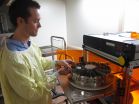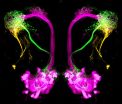UBC scientist finds genetic wrinkle to block sun-induced skin aging
Mice missing key enyzme retain youthful skin
2014-12-16
(Press-News.org) A scientific team at UBC and Providence Health Care have genetically engineered mice with less wrinkled skin, despite repeated exposure to wrinkle-inducing ultraviolet (UV) light.
The youthful-looking mice were bred without the gene that produces Granzyme B, an enzyme that immune cells use to destroy harmful pathogens. The UBC-Providence team, led by Professor David Granville and postdoctoral fellow Leigh Parkinson, found that Granzyme B also does harm: When produced and released by skin cells in response to UV light, it triggers the breakdown of collagen, a structural protein that makes skin firm.
The findings, published last week in Aging Cell, raises hope for a drug that would block the activity of Granzyme B in certain places, and thus prevent the aging and deterioration of tissues that depend on collagen - not just skin, but blood vessels and lung passages.
Granville, a professor in the UBC Department of Pathology and Laboratory Medicine and a principal investigator in the Centre for Heart Lung Innovation of UBC and St. Paul's Hospital, was investigating the role of Granzyme B in atherosclerosis and heart attacks. He and his team wanted to see if the blood vessels of mice lacking Granzyme B were more resistant to hardening and narrowing, which is a major cause of heart attacks in human. In the process, they discovered that such mice retained youthful-looking skin compared to the aged skin on normal mice.
Granville's team constructed an experimental "tanning bed" to simulate sun exposure on mice. Each mouse was put in a carousel that slowly turned under UV lamps, exposing them for three to four minutes, three times a week - enough to cause redness, but not to burn. After 20 weeks of repetitive exposure, it became clear that the skin of mice lacking Granzyme B had aged much less - and their collagen was more intact - compared to the control groups.
viDA Therapeutics, a company co-founded by Granville, is currently developing a Granzyme-B inhibitor based on technology licensed from UBC. The company plans to test a topically applied drug within two years on people with discoid lupus erythematosus, an autoimmune disease worsened by sunlight that can lead to disfiguring facial scarring. (The musician Seal has such a condition.)
If the drug proves effective in preventing lupus-related skin lesions, there is potential for a cosmetic product to prevent the normal, gradual aging of the skin, which is mostly caused by sun exposure. But the drug might also be used for life-threatening conditions, such as aneurysms and chronic obstructive pulmonary disease, caused by the breakdown of collagen and other proteins that provide structure to blood vessels and lung passages.
INFORMATION:
[Attachments] See images for this press release:


ELSE PRESS RELEASES FROM THIS DATE:
2014-12-16
ANN ARBOR--A set of eight hurricane-forecast satellites being developed at the University of Michigan is expected to give deep insights into how and where storms suddenly intensify--a little-understood process that's becoming more crucial to figure out as the climate changes, U-M researchers say.
The Cyclone Global Navigation Satellite System is scheduled to launch in fall 2016. At the American Geophysical Union Meeting in San Francisco this week, U-M researchers released estimates of how significantly CYGNSS could improve wind speed and storm intensity forecasts.
CYGNSS--said ...
2014-12-16
Contrary to popular belief, new research suggests that some employees adapt well to pressures caused by changes in the workplace.
Pay cuts, reduced working hours, fewer training and promotion opportunities are just a few of the measures organisations employ to combat economic downturn and industry competition. Where previous research has suggested cut backs result in a demotivated and unhappy workforce, experts from Monash University and The University of Iowa say this might not necessarily be the case.
A new study published in the Journal of Occupational and Organizational ...
2014-12-16
A global fleet of composite planes could reduce carbon emissions by up to 15 percent, but the lighter planes alone will not enable the aviation industry to meet its emissions targets, according to new research.
The study, by the Universities of Sheffield, Cambridge and UCL (University College London), is the first to carry out a comprehensive life cycle assessment (LCA) of a composite plane, such as the Boeing Dreamliner 787 or Airbus 350, and extrapolate the results to the global fleet.
The LCA covers manufacture, use and disposal, using publicly available information ...
2014-12-16
A team of Chinese and Italian scientists has joined efforts to provide a key to the understudied phaleratus group of blister beetles. During their research the scientists have also discovered a new species from the genus Hycleus, which they named after Marco Polo, as a tribute to their collaboration during the Ph.D. studies. The study was published in the open access journal ZooKeys.
The phaleratus group to which the new species Hycleus marcipoli belongs, is part of the Meloidae family commonly known as the blister beetle family. The representatives of this group get ...
2014-12-16
This news release is available in German. Whether an odor is pleasant or disgusting to an organism is not just a matter of taste. Often, an organism's survival depends on its ability to make just such a discrimination, because odors can provide important information about food sources, oviposition sites or suitable mates. However, odor sources can also be signs of lethal hazards. Scientists from the BMBF Research Group Olfactory Coding at the Max Planck Institute for Chemical Ecology in Jena, Germany, have now found that in fruit flies, the quality and intensity of ...
2014-12-16
Researchers studied 414 people with severe dementia along with their carers in England, Estonia, Finland, France, Germany, the Netherlands, Spain and Sweden. The study gathered information on quality of life, activities of daily living such as bathing, feeding and dressing and presence of depressive symptoms using standardised measures.
In the groups studied, 37% of the 217 people living in the community showed signs of depression compared to 23% of the 197 in care homes. It is one of the few studies comparing similar groups of people living at home and in nursing homes.
Professor ...
2014-12-16
Some neurons are more active than others, even when they are positioned right next to each other and are one and the same neuron type. Dr. Jean-Sébastien Jouhanneau and Dr. James Poulet of the Max Delbrück Center for Molecular Medicine (MDC) Berlin Buch have discovered the cause for this phenomenon. They found that the more active neurons in the somatosensory area of the brain respond to a broader receptive field and probably play a particularly important role in our sensory perception. The findings of the researchers, who also work at the NeuroCure Cluster of ...
2014-12-16
People and animals have been shown to discriminate between quantities. Lions, chimpanzees and hyenas, for example, will only approach a group of attackers if their own group outnumbers that of the intruders. These animals use numerical information to make decisions about their social life.
Testing numerical competence
In 2012 Friederike Range and Zsofia Virányi from the Messerli Research Institute at the University of Veterinary Medicine Vienna showed that wolves are capable of discriminating between different food quantities. In their present study, they asked ...
2014-12-16
Stimulants use such as cocaine and amphetamine is associated with a nearly two-fold greater likelihood of suicidal behaviour amongst people who inject drugs, say researchers at the University of Montreal and the CHUM Research Centre. Drug addiction had already been identified as a major risk factor for suicide, and it is in fact the cause of ten percent of deaths among drug users. The data from this groundbreaking study could help develop and evaluate more appropriate suicide prevention efforts in this highly vulnerable population.
The researchers were able to explore ...
2014-12-16
GPs should consider a more overt discussion with patients when referring them for further investigation of symptoms which may indicate cancer, according to a paper published in the British Journal of General Practice.
In an NIHR-funded study, researchers from the Universities of Bristol, Cambridge, Durham and Exeter conducted interviews with patients being referred for possible lung and colorectal cancer.
They found that patients were rarely involved in the decision to be referred for investigation and that reasons for referral tended to be couched in non-specific ...
LAST 30 PRESS RELEASES:
[Press-News.org] UBC scientist finds genetic wrinkle to block sun-induced skin aging
Mice missing key enyzme retain youthful skin




